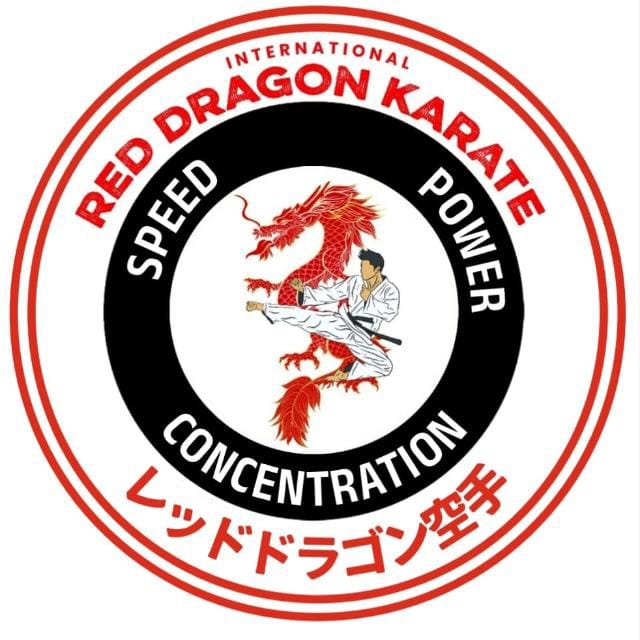Technical Terminology
Technical Terminology
Greetings and Salutes
Osu Patience and Determination. Comes from ‘oshi shinobu’ which means to never give up. It also comes from ‘osu
no seishin’ which means perseverance under pressure.
It is used among Red Dragon practionners to show respect or to say “I understand”.
Shinzen ni rei Greeting to the ancestors
Shomen ni rei Greeting in direction of the person standing in the place of honor (usually more elevated than the students)
Mokuso Meditation (silent thought) / Close your eyes
Mokuso yame Open your eyes
Sensei ni rei Greeting to the teacher
Sempai ni rei Greeting to the assistant teacher
Otagai ni rei Greeting to the other students
Tatte kudasai Stand on your feet (right foot first)
Osu Arigato gozaimashita Thank you so much
Osu Shitsurei shimashita I apologize
Titles and Status
Sosai President
Kancho Director
Hanshi Honorable Master
Shihan Grand Master (5th dan or more)
Sensei School Master / Teacher (3rd dan or more)
Sempai Senior / Teacher’s assistant
Karateka Student
Kohai Junior student
Otagai Each other / Other students
Places and Clothing
Dojo Training Hall
Dogi Training clothes
Obi Belt
Kyu Belt dash for lower belts (colored-belts)
Dan Belt dash for black belts
Kuroi obi Black belt
Basic Terminology (kihon jutsugo)
Bunkai Application (analysis)
Budo Martial Way
Dojo Kun Training Hall Oath
Fumiashi Step (with a change of feet)
Hanmi Upper body shifted angled to avoid direct strike and ready for your next move
Karate Empty hand
Kamaete Take Ready Position
Kata Form
Ki Inner Energy
Kiai Explosive Scream, Yelling, Battle Shout
Kihon Basics
Kihon waza Basic techniques
Kosa Switch (i.e. switch stance L to R or R to L)
Kumite Combat, Sparring, Fighting
Yakusoku kumite Pre-arranged combat
Ippon kumite Pre-arranged combat / 1 block and 1 counter-attack (the two participants are standing at
the same place)
Sanbon kumite Pre-arranged combat / 3 blocks followed by 3 counter-attackes while the participants move
straight.
Jiyu kumite Free-sparring/Semi-Contact fighting
Jissen kumite Full contact fighting
Naore Return to Starting Position
Nogare Calm Controlled Breathing / Breathing technique – breath silently
Rei Bow / Greeting / Homage
Tatte Stand up
Mawatte Turn Around
Hantai Opposite side
Yame Stop
Yasume Rest, at Ease
Yoi Ready
Seiza Formal Kneeling (correct sitting)
Kamaete On guard
Hajime Start
Ryu Style (of karate)
Waza Technique(s)
Directions
Jodan Upper Level
Chudan Middle Level
Gedan Lower Level
Age Rising / While raising
Hidari Left
Juji Cross arm
Kake Hooked
Mae Front, forward
Mawashi Round, Circular
Migi Right
Naname In diagonal, at 45 degrees
Oroshi Descending / While going down
Sagari While going backward
Sayu Left and right alternatively
Shita From below / down
Shomen Front of Dojo
Soto From outside to inside, outside
Tobi While jumping
Naka / Uchi Fron inside to outside, inside
Ura Reverse, Backward
Ushiro Behind
Yoko On sides, from sides
Colors
Aka Red
Shiro White
Kiiro Yellow
Cha Brown
Ao Blue
Midori Green
Kuro Black
Body Weapons – The hand and arms as weapon
Seiken Fist / Forefist (correct fist)
Shuto Knife hand
Te Hand
Hiji / Enpi Elbow
Tetsui Hammer fist
Koken Arc fist
Uraken Reverse fist / Back hand
Haisho Backhand
Haito Reverse knife hand
Hiraken Flat Fist
Nukite Finger tip strike
Nakayubi Ippon Ken Middle Finger Knuckle Fist
Oyayubi Ippon Ken Thumb Knuckle Fist
Shotei Palm heel
Kote Forearm
Body Weapons – The leg and foot as a weapon
Sokuto Knife edge foot
Haisoku Instep
Kakato Heel
Hiza Knee
Chusoku Ball of the foot
Teisoku Arch of the foot
Tsumasaki Toe
Body parts as a target
Jodan (Neck and Head)
Ago Chin / Jaw
Me Eye
Hana Nose
Nodo Throat
Komekami Temple
Kuchi Mouth
Mimi Ear
Kubi Neck
Ganmen Face/Side Face
Jinchu Spot between nose and mouth
Miken Spot between eyes
Atama Head
Chudan (Torso area)
Suigetsu / Hara Stomach / Solar Plexus
Mune Chest
Sakotsu Clavicle / Collarbone
Rokkotsu / Abara Rib
Kata Shoulder
Hizo Spleen
Kanzo Liver
Senaka / Ushiro Back
Shinzo Heart
Ude Arms
Te Hand
Yubi Finger
Tekubi Wrist
Kobushi / Ken Fist
Gedan (Groin and legs)
Kinteki (kin) Groin
Ashi Leg
Hiza Knee
Kansetsu Joint
Momo Thigh
Koshi Hip
Sune Shin
Kakato Heel
Fukurahagi Calf
Kihon Waza (Basic techniques)
Tsuki Punch (thrust)
Uchi Strike
Uke Block
Geri Kick
Numbers (kazu)
1 (Ichi)
2 (Ni)
3 (San)
4 (Shi / Yon)
5 (Go)
6 (Roku)
7 (Shichi / Nana)
8 (Hachi)
9 (Kyu)
10 (Jyu)
11 (Jyu Ichi)
12 (Jyu Ni)
13 (Jyu San)
14 (Jyu Shi)
15 (Jyu Go)
16 (Jyu Roku)
17 (Jyu Shichi)
18 (Jyu Hachi)
19 (Jyu Kyu)
20 (Ni Jyu)
30 (San Jyu)
40 (Yon Jyu)
50 (Go Jyu)
60 (Roku Jyu)
70 (Nana Jyu)
80 (Hachi Jyu)
90 (Kyu Jyu)
100 (Hyaku)
1000 (Sen)
10000 (Man)


